Is a Fissure a Lump?

Anal fissures are small tears in the lining of the anus and can form a lump or skin tag. They may be caused by the passage of hard stools with chronic constipation and are characterized by bleeding, pain, and a burning sensation during and after bowel movements.
An anal fissure is a noncancerous condition in itself, but it may be formed due to cancer of the colon or anus (anal cancer). Anal cancer is a rare malignancy of the anal canal, the short tube at the end of the rectum.
What are the signs and symptoms of anal cancer?
Approximately 20% of people with anal cancer may not show any symptoms. However, seek immediate medical attention if you notice any of the following symptoms:
- Bleeding from the anus
- Pain while passing stools
- Mass/growth/lump in the anal opening
- Anal itching
- Abnormal discharge from the anus
- Incontinence (loss of bowel control)
- Change in bowel habits such as frequent bowel movements or increased difficulty in passing stools
What are risk factors for anal cancer?
Anal cancer usually affects adults who are 55 years and older, and women are more likely to be affected than men. The most common risk factor for anal cancer is infection with human papillomavirus (HPV; a sexually transmitted virus). Other risk factors include:
- Age (people age 55 and older are more vulnerable)
- Multiple sexual partners
- Anal sex
- Smoking
- History of HPV-related cancer
- Chronic inflammatory conditions of the anus such as fistulas or wounds in the anal canal
- History of pelvic radiation therapy for rectal, prostate, or cervical cancer
- Weak immune system due to conditions such as human immunodeficiency virus, acquired immunodeficiency syndrome, chemotherapy, or organ transplant recipients
How is anal cancer diagnosed?
Doctors can diagnose anal cancer based on symptoms, medical history, lifestyle, and family history. Tests used to diagnose the disease include:
- Digital rectal examination: Outpatient procedure in which the doctor inserts a gloved, lubricated finger into the anus to feel for lumps, lesions, or swollen lymph glands.
- Anal lining swabs: Swab is scraped from the anal canal and viewed under a microscope to detect the presence of anything unusual.
- Anoscopy: Procedure performed using an anoscope to visualize any abnormalities in the anal canal.
- Colonoscopy: Procedure performed with a flexible tube called a colonoscope to see the inside of the large bowel.
- Biopsy: Sample tissue is snipped and studied in a lab.
- Endoanal ultrasound: Uses high-frequency sound waves to evaluate the structure of the sphincter and thickness of the muscles surrounding the anal canal
- Magnetic resonance imaging: Used to determine the extent of cancer after diagnosis
- Positron emission tomography-computed tomography: Nuclear medicine scan that uses a small amount of radioactive material to provide imaging of body functions.
Is anal cancer curable?
When treated early, anal cancer has high cure rates. Treatments vary depending on the size, extent, and location of the cancer:
- Surgery: Cancerous area is surgically removed
- Radiation therapy: High-dose X-rays are used to kill cancer cells.
- External beam therapy: High-energy X-ray beams are generated by a machine to target tumor cells.
- Internal radiation or brachytherapy: Radioactive material is placed directly into or near a tumor.
- Chemotherapy: Drugs are used to kill cancer cells.
How to prevent anal cancer
Lifestyle changes can help prevent anal cancer. One of the most important preventive measures is to avoid HPV infection. You can lower your risk of HPV by:
- Limiting the number of sexual partners
- Using condoms during sex
- Avoiding sex with people with sexually transmitted diseases or who have had multiple sexual partners
- Avoiding/quitting smoking or using other types of tobacco
- HPV vaccination (Gardasil is approved for the prevention of anal cancer in both sexes)
